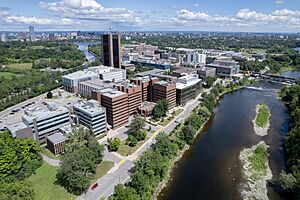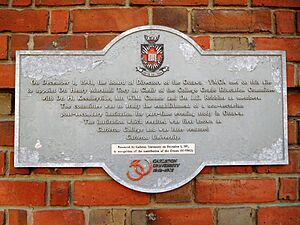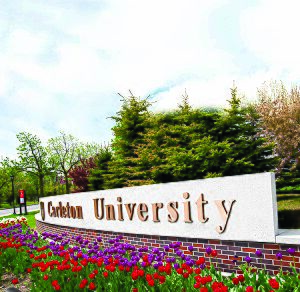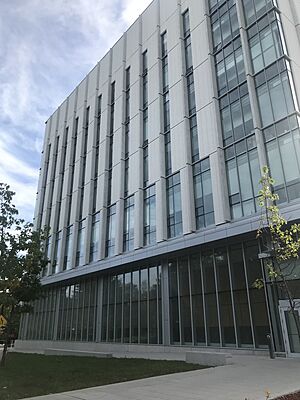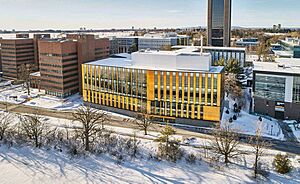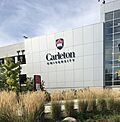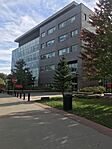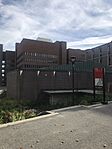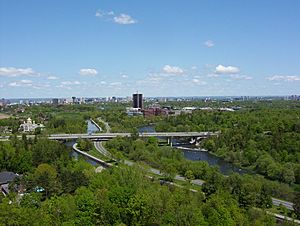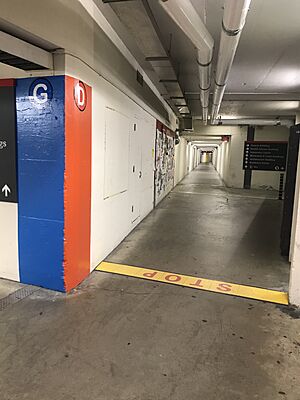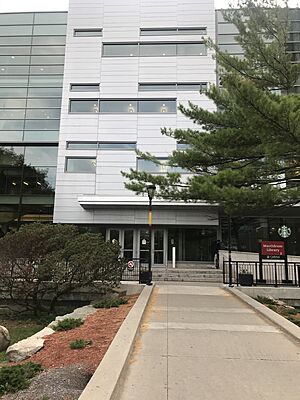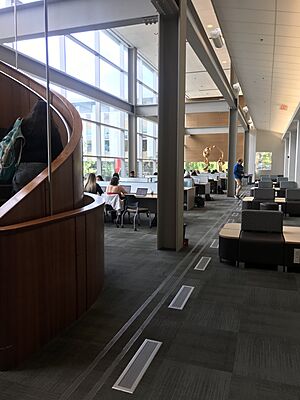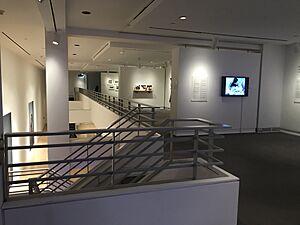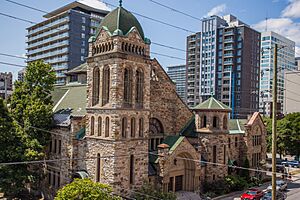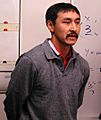Carleton University facts for kids
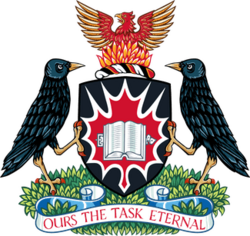
|
||||
| Motto | "Ours the Task Eternal" | |||
|---|---|---|---|---|
| Type | Public | |||
| Established | 1942 | |||
|
Academic affiliations
|
AACSB, ASAIHL, APSIA, CARL, COU, Fields Institute, Universities Canada, UArctic | |||
| Endowment | C$370.2 million | |||
| Budget | C$560 million | |||
| Chancellor | Nik Nanos | |||
| President | Wisdom Tettey (also Vice-Chancellor) | |||
|
Administrative staff
|
5,328 | |||
| Students | 30,760 | |||
| Undergraduates | 25,722 | |||
| Postgraduates | 5,038 | |||
| Address |
45°22′59″N 75°41′51″W / 45.3831°N 75.6976°W |
|||
| Campus | Urban, 62 ha (150 acres) | |||
| Newspaper | The Charlatan | |||
| Colours | Black, Red and White
|
|||
| Nickname | Ravens | |||
|
Sporting affiliations
|
U Sports, OUA, RSEQ | |||
| Mascot | Rodney the Raven | |||
 |
||||
Carleton University is a public research university in Ottawa, Ontario, Canada. It teaches in English. The university started in 1942 as Carleton College. It was a private school for veterans returning from World War II.
In 1952, the government officially made it a university. It was named after Carleton County, where Ottawa was located at the time.
Carleton University has five main faculties and offers over 65 different degree programs. It also has special schools like the Carleton School of Journalism.
As of 2023, more than 30,000 students attend Carleton. This includes over 25,000 undergraduate students and 5,000 graduate students. The campus is about 150 acres. It is located near the Rideau Canal and Rideau River.
Many famous people have studied at Carleton. This includes seven Rhodes Scholars and two Pulitzer Prize winners. The university is also home to many top researchers.
Carleton's sports teams are called the Carleton Ravens. They compete in the U Sports league. The Ravens men's basketball team has won 20 national titles in the last 20 seasons.
Contents
History of Carleton University
Carleton College: The Early Years (1942–1957)
People in Ottawa started talking about a new college in 1938. They wanted a school for non-Catholic students. Henry Marshall Tory helped start the Ottawa Association for the Advancement of Learning in 1941. The college officially opened in 1942.
Carleton College began by offering evening classes. These were held in rented rooms at the High School of Commerce. The first classes included English, French, history, and science subjects.
After World War II ended in 1945, many veterans returned. Student numbers grew quickly, with 2,200 new students joining. The college had to rent more spaces around the city. They even used church basements for classes.
In 1946, Carleton opened its first campus. It was in a four-story building that used to be the Ottawa Ladies' College. The first degrees were given out in 1946 for Journalism and Public Administration.
The college ran on a small budget for many years. Money came from community efforts and student fees. In 1952, a law was passed that allowed Carleton to grant university degrees. This made it Ontario's first private, non-religious college.
The current campus land was acquired starting in 1947. A large part of it was donated by Harry Stevenson Southam. In 1956, construction began on the new campus by the Rideau River.
Carleton University: Growth and Development (1957–Present)
In 1957, Carleton College officially became Carleton University. This change gave it the status of a public university.
Fast Growth in the 1960s
The university moved to its current location in 1959. The first three buildings were the Maxwell MacOdrum Library, Norman Paterson Hall, and the Henry Marshall Tory Building. These became the main academic areas.
Student numbers grew very fast in the 1960s. They went from 857 to over 7,000 students. The government also gave more money to universities.
To house more students, the first dorms opened in 1962. These were Lanark and Renfrew Houses. Carleton was the first university in North America to have co-ed dorms in 1969. More academic buildings were built, like the Loeb Building and Mackenzie Building.
In 1967, Saint Patrick's College, a Catholic college, joined Carleton. A new building for it was built on the Carleton campus in 1973.
Steady Expansion (1970–1999)
The Nideyinàn (formerly University Centre) opened in the 1970s. It became a hub for student life. Dunton Tower, which was Canada's tallest academic building at the time, opened in 1972.
The Athletics Centre was built in 1974. It has many sports facilities, including a pool and gym. In 1979, Saint Patrick's College fully merged with Carleton. The St. Patrick's Building kept its name to remember the college.
Student numbers grew again in the 1980s. This led to new buildings like the Life Sciences Research Centre. The MacOdrum Library also got an extension.
In 1992, the Carleton University Art Gallery opened. In 1994, all students and faculty got Internet and email access.
Modern Developments (2000–Present)
The 2000s brought more money for new buildings. New athletics facilities and the Human Computer Interaction Institute were built. Nideyinàn also received a big upgrade.
In 2008, Frontenac House, a new dorm, was added. Roseann Runte became Carleton's first female President in 2008. She helped plan and build three new academic buildings: Canal Building, River Building (now Richcraft Hall), and the Health Sciences Building. A new dorm, Lennox and Addington House, also opened.
More construction projects have continued. The Advanced Research and Innovation and Smart Environments (ARISE) Building is replacing the old Life Sciences Building.
In 2018, Carleton bought the Dominion-Chalmers United Church downtown. It is now a community and cultural center.
In 2021, the Nicol Building was completed. It is the new home for the Sprott School of Business. This building cost $65 million, with a large donation from Wes Nicol.
How Carleton University is Organized
Leadership and Management
Carleton University is governed by two main groups: the Board of Governors and the Senate. The Carleton University Act, 1952 sets out how the university should operate. It states that Carleton aims to advance learning and knowledge. It also works to develop its members and the community.
Board of Governors
The Board of Governors handles the university's business side. This includes money, property, and future plans. They also choose the President and Chancellor. The Board has 36 members. Some are students, staff, and faculty from Carleton. Others are from the local community.
The Board has six committees that help with its work. These include committees for finances and building projects. The Board is led by a chair, who oversees meetings and advises the university's leaders. The current chair is Beth Creary.
Senate
The Senate focuses on academic matters. It has 86 members. These include faculty members, students, and other university leaders.
Money Matters
For the 2023-24 school year, Carleton's budget was about $525 million.
The university gets most of its money from student tuition fees. This makes up 50% of its income. Government funding provides another 26%.
In 2023–24, Carleton received $116 million for research projects. The university also has an endowment fund of $353 million. This fund grew by $54.4 million in the previous year.
Academics at Carleton
Carleton is a medium-sized public university known for its research. It is part of national and international university groups. In the 2020–21 school year, Carleton received over 23,500 applications. About 6,200 new students joined that year.
In 2023, Carleton had 30,760 students. This included 25,722 undergraduate and 5,038 graduate students. There are 1,062 faculty members and 861 contract instructors. About 70% of students graduate within seven years. About 93% of graduates find jobs within two years. Most of them work in fields related to their degrees.
| Faculties | Established |
|---|---|
| Faculty of Arts & Social Science | 1997 |
| Faculty of Engineering & Design | 1963 |
| Faculty of Public and Global Affairs | 1997 |
| Faculty of Science | 1963 |
| Sprott School of Business | 2006 |
Academic Departments
Arts and Social Sciences
The Faculty of Arts and Social Sciences (FASS) offers many programs. These include 27 majors and 16 minors. Students can earn Bachelor of Arts degrees in subjects like English, history, music, and psychology.
The faculty also has the College of the Humanities. It offers a unique "Great Books" program. Carleton's Institute of Cognitive Science has the only full PhD program in Cognitive Science in Canada. FASS offers 14 master's and nine doctoral programs.
Engineering and Design
The Faculty of Engineering and Design is one of the oldest at Carleton. Engineering courses started in 1945. Four-year engineering degrees began in 1956.
The faculty offers many programs in engineering, architecture, and industrial design. There are 20 undergraduate programs and 37 graduate programs. In fall 2019, over 5,800 undergraduate and 1,200 graduate students were in this faculty.
Carleton has one of Canada's first programs in aerospace engineering. Students can choose to specialize in areas like aerodynamics or space systems design.
The Azrieli School of Architecture and Urbanism is also part of this faculty. It offers programs in Architecture. Carleton's Information Technology programs are offered with Algonquin College.
Public Affairs
The Faculty of Public and Global Affairs focuses on government and society. It has twelve academic units. It offers 12 undergraduate and 21 graduate programs. These include subjects like criminology, economics, journalism, and political science. In 2024, its name changed to include "Global Affairs."
Many of Carleton's top programs are in this faculty. The Carleton School of Journalism offers Bachelor and Master of Journalism programs. The Norman Paterson School of International Affairs (NPSIA) is Canada's oldest graduate program in foreign affairs.
The School of Public Policy and Administration is also the oldest of its kind in Canada. The Arthur Kroeger College of Public Affairs offers unique degrees in Public Affairs and Policy Management.
Carleton was named a European Union Centre of Excellence in 2006. Its Department of Law & Legal Studies is Canada's oldest law department to study law's influence in society.
In 2019, Carleton ranked among the top universities worldwide for politics and international studies.
Norman Paterson School of International Affairs
The Norman Paterson School of International Affairs (NPSIA) is a top school for international affairs at Carleton. It started in 1965. NPSIA is known as Canada's leading school in this field. Its graduates often get important jobs in government and research.
The school uses an interdisciplinary approach. This means it combines different subjects to study global issues. NPSIA is a founding member of a group of the world's best international affairs schools.
Science
The Faculty of Science offers 86 undergraduate and 39 graduate programs. These cover fields like biology, chemistry, physics, health sciences, and computer science. Over 6,500 students are enrolled.
Science courses were first offered as night classes in 1942. The first science degrees were introduced in 1947.
The faculty has eleven departments. They are housed in buildings like Herzberg Laboratories and the Health Sciences Building. These buildings have labs for research. The Nesbitt Biology Building has greenhouses. They host an annual Butterfly Show that attracts many visitors.
The National Wildlife Research Centre is also on campus. It studies the effects of toxic substances on wildlife.
Sprott School of Business
Carleton started offering a Bachelor of Commerce degree in 1949. The Sprott School of Business became a separate faculty in 2006.
The school offers two undergraduate programs: Bachelor of Commerce and Bachelor of International Business. It also has five graduate programs. As of 2023–24, 2,043 undergraduate students attend Sprott.
Sprott is recognized internationally by business school associations. It was the first in Canada to offer a Bachelor of International Business. The school has won awards for its research contributions.
Admissions to Carleton
For the 2018–2019 school year, Carleton admitted 5,988 first-year undergraduate students. In 2022–2023, the average grade for new undergraduate students was 87.3%.
Admission requirements vary by program. Some specialized programs, like Aerospace Engineering, require higher grades.
Scholarships and Financial Aid
In the 2022–23 school year, over 15,000 scholarships and bursaries were given to students. These totaled over $31.9 million.
High school students with an average above 80% can get an entrance scholarship. It starts at $4,000 over four years. Students with averages above 95% can receive $16,000. To keep the scholarship, students must maintain good grades.
Rankings and Reputation
| University rankings | |
|---|---|
| Global rankings | |
| ARWU World | 501–600 |
| QS World | 741–750 |
| Times World | 501–600 |
| U.S News & World Report Global | 617 |
| Canadian rankings | |
| ARWU National | 19–20 |
| QS National | 24 |
| Times National | 21–24 |
| U.S News & World Report National | 20 |
| Maclean's Comprehensive | 4 |
| Maclean's Reputation | 21 |
Carleton University is included in many university rankings. In 2022, the Academic Ranking of World Universities placed it in the 501–600 range globally. The 2023 QS World University Rankings put Carleton in the 601–650 range worldwide.
The 2023 Times Higher Education World University Rankings ranked Carleton in the 601–800 range. In the 2022–23 U.S. News & World Report Best Global University Ranking, Carleton was 526th in the world.
In 2009, a survey of academics ranked Carleton's Norman Paterson School of International Affairs (NPSIA) 14th in the world. A 2015 survey recommended Carleton as the best choice for students wanting a career in policy.
Maclean's, a Canadian magazine, ranks Canadian universities each year. In its 2025 edition, Carleton ranked fourth in the "comprehensive" category.
In 2019, Maclean's ranked Carleton 7th in Canada for engineering. It was 10th in computer science and mathematics.
In 2024, 85 Carleton researchers were named among the world's most-cited scholars. Carleton was also recognized as one of Canada’s Top 100 Employers for the third year in a row.
Partner Institutions
- Dominican University College: This is an independent, bilingual Catholic school in Ottawa. It offers degrees in philosophy and theology. It has been connected with Carleton since 2012.
Carleton University Campus
- Carleton University campus
-
Dunton Tower viewed from Hartwells Locks
Carleton's campus covers 153 acres. It is bordered by the Rideau Canal and Rideau River. The campus is next to the Dominion Arboretum.
When it was first built in 1959, the campus had three buildings. Today, it has 48 buildings. The newest is the Nicol Building, opened in 2021.
You can enter the campus from Bronson Avenue and Colonel By Drive. Campus Avenue is a main road on campus.
Several OC Transpo bus lines serve the campus. The O-Train's Carleton station is also in the center of campus.
The O-Train Line 2 cuts through the campus. Bridges and tunnels connect both sides. Most academic and residential buildings are on the west side. Sports facilities and administrative offices are on the east side.
Campus Architecture
The early buildings at Carleton used a modern and brutalist architecture style. This was different from the older Gothic style of many universities. This design choice showed Carleton as a modern and forward-thinking school.
Carleton's campus is seen as a great example of modern college architecture in Canada.
Underground Tunnels
Most buildings on campus are connected by a five-kilometer system of underground tunnels. This is the largest tunnel network at a Canadian university.
The tunnels were built in the 1960s. They were first meant for maintenance. But a staff member suggested making them for students and faculty to use. The tunnels are very popular in winter because of Ottawa's cold weather.
In 2019, Carleton added a new wayfinding system for the tunnels. It uses a map like a subway system.
Student Housing
In 1969, Carleton was the first university in North America to have co-educational dorms. Since then, more dorms have been added as student numbers grew.
On-campus housing includes traditional and suite-style rooms. Suite-style rooms have a small kitchen shared by four students. Bathrooms are usually shared between two rooms.
Older students called "Residence Fellows" live on each floor. They help students with personal and academic support.
Library and Collections
MacOdrum Library
The MacOdrum Library is one of Carleton's original buildings. It is the main library and archives. The library is named after former Carleton President Murdoch Maxwell MacOdrum.
As of 2022, the Library has about 1.2 million print books and 2.7 million e-books. It also has over 260,000 e-journals. During exams, the library stays open 24 hours. Over 1.6 million people visit the library each year.
In 2013, the Discovery Centre for Undergraduate Research opened. It has meeting spaces, multimedia areas, and 3D printers. In 2023, the fourth floor became the Future Learning Lab. It has spaces for studying and workshops.
The library often hosts exhibitions. It also has a Book Arts Lab. Here, students can learn about printing and bookbinding.
Archives and Special Collections
The MacOdrum Library has special collections of documents and artifacts. These relate to different subjects and important people.
Notable collections include the W. McAllister Johnson Collection. It has artwork from 17th and 18th century French art history. The Uganda Collection has materials about the expulsion of South Asians from Uganda. The library also keeps materials about Carleton University's own history.
Carleton University Art Gallery
The Carleton University Art Gallery (CUAG) opened in 1992. It is located in the St. Patrick's Building. CUAG has three galleries, offices, and storage vaults.
Admission to the gallery is free. It is open from Tuesday to Sunday. CUAG also has a Curatorial Laboratory for student and community art.
Past exhibitions have included photography from World War II. Others showed protest art and Inuit printmaking.
CUAG also manages the university's art collection. It focuses on Canadian art after 1950. It also has European prints and Inuit and First Nations art.
Carleton Dominion-Chalmers Centre
In 2018, Carleton bought the Dominion-Chalmers United Church. It is now the Carleton Dominion-Chalmers Centre (CDCC). It is Carleton's arts, performance, and learning center downtown.
The CDCC is about 37,000 square feet and can seat about 1,000 people. It still hosts religious services for the church. It also provides arts programs and learning opportunities for the community.
Student Life
| Undergraduate | Graduate | |
|---|---|---|
| Male | 52.7% | 51.5% |
| Female | 47.3% | 48.5% |
| Canadian student | 88.6% | 78.8% |
| International student | 11.4% | 21.2% |
Student Organizations and Services
Carleton University Students' Association (CUSA)
All undergraduate students are members of the Carleton University Students' Association (CUSA). CUSA was founded in 1942. It represents students' interests to the university. It also organizes Orientation Week and supports student clubs.
CUSA is led by six elected student executives. Undergraduate students also elect 28 Councillors from different faculties.
CUSA runs several student centers. These include the Mawandoseg Centre and the Food Centre. They also operate businesses like Oliver's Pub and Patio and Rooster's Coffeehouse.
Rideau River Residence Association (RRRA)
Students living in university residences are members of the Rideau River Residence Association (RRRA). RRRA was founded in 1968. Students elect a three-member executive and floor representatives. RRRA hosts events for residents. It also runs Abstentions, a convenience store.
Graduate Students' Association (GSA)
All graduate students are members of the Carleton University Graduate Students' Association (GSA). Graduate students elect an executive and council members. The GSA represents their interests. It also provides services like a Grad Lounge and Mike's Place, a student pub.
Fraternities and Sororities
Since 2007, most Greek activities at Carleton are overseen by the Carleton University Greek Council (CUGC). This student group plans social, charity, and academic events. Three international sororities are governed by the Carleton Panhellenic Council.
Student Newspapers and Magazines
Carleton's main undergraduate student newspaper is The Charlatan. It was founded in 1945. The newspaper publishes monthly.
The Leveller is another monthly newspaper. It started in 2009 and focuses on social issues.
The School of Journalism publishes Centretown News, a community newspaper. They also have an online newspaper called Capital News Online.
The English Department supports In/Words, a student-run magazine. Engineering students have their own paper, The Iron Times.
Student Broadcasting
Carleton has a community radio station, CKCU-FM. It started broadcasting in 1975. It was Canada's first licensed community-based campus radio station. CKCU-FM plays many types of music and has multicultural programs.
Student Theatre
The Sock 'n' Buskin Theatre Company started in 1943. It is Carleton's amateur theatre company. The company puts on various plays each year. Recent productions include The Crucible and As You Like It. Students run the company and act in the plays.
Athletics
Carleton's sports teams are the Carleton Ravens. They compete in national and provincial competitions. Carleton is part of U Sports and Ontario University Athletics. Some teams also compete in Quebec. There are 13 varsity sports teams.
Men's Basketball
Carleton is famous for its strong men's basketball team. Dave Smart was the head coach from 1999 to 2019. He helped build the team's success. He is now the director of basketball operations.
Women's Basketball
The Ravens women's basketball team is also very strong. They won the U SPORTS National Championship in 2018, 2023, and 2024. The team has helped develop many professional players.
Football
Carleton started a football team in 1945–46. Football games became a big part of student life. In 1959, the new campus gave the team better facilities.
Since 1955, the football team has played in the annual Panda Game. This is a rivalry game against the Ottawa Gee-Gees. The game is a popular event for students. It was stopped in 1999 but brought back in 2013. Since 2014, the game has been held at TD Place Stadium. Carleton won four games in a row from 2014 to 2017.
Other Sports
The Carleton Ravens men's ice hockey team plays in the Ontario University Athletics conference. They also have a rivalry with the University of Ottawa. They compete in the annual Colonel By Classic.
The Ravens women's hockey team plays in the RSEQ.
Carleton also has a very successful soccer program. The men's soccer team won silver medals in 2021, 2002, and 1984.
Carleton's men's and women's fencing teams compete in the OUA. The men's team won its last championship in 2015. The women's team won in 2013.
In 2024, the women's nordic ski team won its second CCUNC Championship. They have won seven of the last eight OUA Women's Championships.
Notable People from Carleton
-
John Manley, former Deputy Prime Minister of Canada
-
Omar Sharmarke, former Prime Minister of Somalia
-
Peter MacKay, former Minister of National Defense of Canada
-
Rob Ford, former Mayor of Toronto
-
Jim Watson, former Mayor of Ottawa
-
Paul Okalik, former Premier of Nunavut
-
Arielle Kayabaga, Leader of the Government in the House of Commons of Canada
-
Peter Grünberg, Nobel laureate in physics
-
Lawrence Krauss, theoretical physicist and New York Times bestselling author
-
Dan Aykroyd, Academy Award–nominated actor
-
Shane Smith, founder of Vice Media
-
David Azrieli, Canadian real estate tycoon
Notable Faculty
Carleton has had many important faculty members. These include three Nobel winners: Gerhard Herzberg and Peter Grünberg (physics and chemistry), and former Prime Minister of Canada, Lester B. Pearson. Six faculty members have also received the Order of Canada.
Chancellors
The Chancellor is a ceremonial head of the university. Herb Gray, a long-serving Canadian politician, was the 10th Chancellor. He was followed by Charles Chi, a venture capitalist. Yaprak Baltacioğlu, a former government official, became the 12th Chancellor in December 2018. In 2022, Professor Lenore Fahrig won the prestigious Herzberg Prize. She was the first Carleton faculty member to win this award.
Notable Alumni
Many Carleton graduates have become famous in different fields. These include politicians, journalists, lawyers, business people, and entertainers.
Journalism is a strong area for Carleton. Many alumni work in top media roles. These include news anchors Rosemary Barton and Andrew Chang. Paul Watson is a Pulitzer Prize-winning photojournalist. Shane Smith founded Vice Media.
Carleton alumni have worked in all levels of Canadian government. This includes Greg Fergus, the Speaker of the House of Commons. Also, former Deputy Prime Minister John Manley.
In architecture, Paul Denham Austerberry won an Academy Award for his work on the film The Shape of Water. David Azrieli, a real estate billionaire, also studied architecture at Carleton. He donated to buildings on campus.
Dan Aykroyd, a famous actor, attended Carleton. He received an honorary degree in 1994. Comedian Norm Macdonald and journalist Peter Jennings also attended. Other alumni in entertainment include rapper k-os and pop singer Mia Martina.
Arms
See also
 In Spanish: Universidad de Carleton para niños
In Spanish: Universidad de Carleton para niños
- Carleton Ravens
- Carleton School of Journalism
- Carleton O-Train Station
- Carleton University Students' Association
- The Charlatan, student newspaper
- CKCU-FM Radio Carleton
- Dominican University College
- Higher education in Ontario
- List of Carleton University people
- List of Ontario Universities
- Rideau River Residence Association
- U Sports


